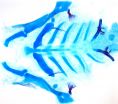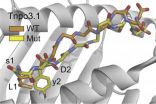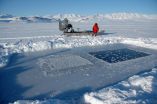(Press-News.org) A person's face is the first thing that others see, and much remains unknown about how it forms — or malforms — during early development. Recently, Chong Pyo Choe, a senior postdoctoral fellow working in the lab of USC stem cell researcher Gage Crump, has begun to unwind these mysteries.
In a September study published in the journal Development, Choe and Crump describe how a mutation in a gene called TBX1 causes the facial and other deformities associated with DiGeorge syndrome.
During prenatal development, a series of segments form that eventually organize many features of the face. These segments, or "pouches," are composed of a type of specialized tissue called epithelium, which also forms the skin, glands and linings of organs such as the lungs, heart and intestines.
In mice and zebrafish with TBX1 mutations, these pouches never properly develop and the face is deformed, mimicking the severe facial defects typical of DiGeorge syndrome.
By using sophisticated time-lapse imaging, Crump and Choe observed how this happens in both normal and abnormal development. TBX1 works by activating additional genes, including one called Fgf8a that attracts pouch-forming cells to move to the correct locations. This enables the growing pouches to take shape.
"Whereas it has been recognized that mutations in TBX1 underlie DiGeorge syndrome in patients, our study reveals how this master control gene works to organize the complex cellular rearrangements that build the face," said Crump, associate professor and principal investigator at the Eli and Edythe Broad Center for Regenerative Medicine and Stem Cell Research at USC.
INFORMATION:
Funding for this study came from a National Institute of Dental and Craniofacial Research (NIDCR) grant (R01DE022572) and a California Institute for Regenerative Medicine (CIRM) training fellowship.
University of Southern California researchers reveal how gene expression affects facial expressions
2014-09-22
ELSE PRESS RELEASES FROM THIS DATE:
New 'star' shaped molecule breakthrough
2014-09-22
Scientists at The University of Manchester have generated a new star-shaped molecule made up of interlocking rings, which is the most complex of its kind ever created.
Known as a 'Star of David' molecule, scientists have been trying to create one for over a quarter of a century and the team's findings are published in the journal Nature Chemistry.
Consisting of two molecular triangles, entwined about each other three times into a hexagram, the structure's interlocked molecules are tiny – each triangle is 114 atoms in length around the perimeter. The molecular triangles ...
Fracking's environmental impacts scrutinized
2014-09-22
Greenhouse gas emissions from the production and use of shale gas would be comparable to conventional natural gas, but the controversial energy source actually faired better than renewables on some environmental impacts, according to new research.
The UK holds enough shale gas to supply its entire gas demand for 470 years, promising to solve the country's energy crisis and end its reliance on fossil-fuel imports from unstable markets. But for many, including climate scientists and environmental groups, shale gas exploitation is viewed as environmentally dangerous and ...
New rules for anticancer vaccines
2014-09-22
Scientists have found a way to find the proverbial needle in the cancer antigen haystack, according to a report published in The Journal of Experimental Medicine.
As cancer cells divide, they accumulate random mistakes (mutations). This process creates new versions of proteins, some of which are recognized as foreign invaders by immune cells called T cells, prompting the cells to attack and eliminate the cancer cells. With our current ability to identify all of the mutations in a patient's cancer and to understand which protein sequences can be recognized by T cells, ...
Classroom intervention helps shy kids learn
2014-09-22
A program that helps teachers modify their interactions with students based on an individual's temperament helps shy children to become more engaged in their class work, and in turn, improves their math and critical thinking skills.
Led by NYU's Steinhardt School of Culture, Education, and Human Development, the study offers an evidence-based intervention to help shy children, who are often at risk for poor academic achievement. The findings appear in the Journal of School Psychology.
Shy children are described as anxious, fearful, socially withdrawn, and isolated. ...
Arctic sea ice helps remove CO2 from the atmosphere
2014-09-22
Due to global warming, larger and larger areas of sea ice melt in the summer and when sea ice freezes over in the winter it is thinner and more reduced. As the Arctic summers are getting warmer we may see an acceleration of global warming, because reduced sea ice in the Arctic will remove less CO2 from the atmosphere, Danish scientists report.
"If our results are representative, then sea ice plays a greater role than expected, and we should take this into account in future global CO2 budgets", says Dorte Haubjerg Søgaard, PhD Fellow, Nordic Center for Earth Evolution, ...
Nurse survey shows longer working hours impact on quality of care
2014-09-22
Results of a survey of more than 30,000 nurses across Europe show that nurses who work longer shifts and more overtime are more likely to rate the standard of care delivered on their ward as poor, give a negative rating of their hospitals safety and omit necessary patient care.
Led by researchers at the University of Southampton and the National Nursing Research Unit (NNRU) at King's College London, the RN4CAST survey of nurses in over 450 hospitals across 12 European countries, was part of an international research programme looking at links between nursing workforce ...
Singapore researchers discover a gene that increases incidence of AML
2014-09-22
A novel study by the Cancer Science Institute of Singapore (CSI Singapore) at the National University of Singapore (NUS) found that an increase in a gene known as Leo1 affects other genes that are directly implicated in acute myelogenous leukaemia (AML), increasing the incidence of cancer.
Led by Associate Professor Chng Wee Joo, Deputy Director and Senior Principal Investigator at CSI Singapore and Director of the National University Cancer Institute, Singapore, the scientists discovered that inhibition of Leo1 and Leo1 downstream signalling pathways provide an avenue ...
New guidelines issued for managing peri- and postoperative atrial fibrillation
2014-09-22
Beverly, MA, September 22, 2014 – The American Association for Thoracic Surgery (AATS) has released new evidence-based guidelines for the prevention and treatment of perioperative and postoperative atrial fibrillation (POAF) and flutter for thoracic surgical procedures. The guidelines are published in The Journal of Thoracic and Cardiovascular Surgery.
"These guidelines have the potential to prevent the occurrence of atrial fibrillation in thousands of patients who undergo lung surgery in the United States each year. The AATS is committed to its goal of improving the ...
Evidence supports deep brain stimulation for obsessive-compulsive disorder
2014-09-22
September 22, 2014 – Available research evidence supports the use of deep brain stimulation (DBS) for patients with obsessive-compulsive disorder (OCD) who don't respond to other treatments, concludes a review in the October issue of Neurosurgery, official journal of the Congress of Neurological Surgeons (CNS). The journal is published by Lippincott Williams & Wilkins, a part of Wolters Kluwer Health.
Based on evidence, two specific bilateral DBS techniques are recommended for treatment of carefully selected patients with OCD, according to a new clinical practice guideline ...
Involving female offenders in release planning can increase reintegration success
2014-09-22
TORONTO, Sept, 22, 2014--Women who are about to be released from prison need to be more involved in their discharge planning if they are to successfully reintegrate into their communities and avoid returning to prison, according to a new study.
Almost half of all female prisoners are back behind bars within one year of their release and most have multiple prison terms, mainly for drug-related offenses.
Dr. Flora Matheson, a researcher at St. Michael's Hospital, conducted one-on-one interviews with women who were about to be released or had been recently released from ...



